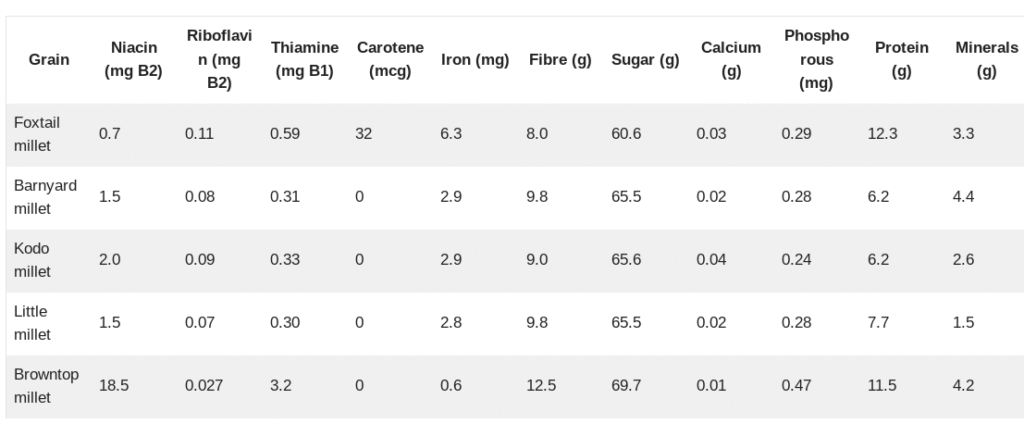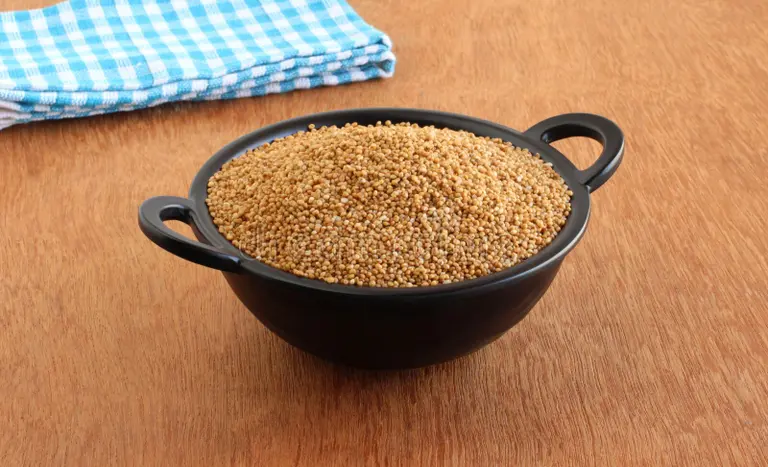Before we dive deep into what is Kodo millet & Kodo millet benefits, take a moment to explore our blog post: What is Millet? This foundational guide offers more than just facts — it carries the wisdom and research of the renowned “Millet Man of India”, whose dedication has brought ancient grains back into the spotlight.
Table of Contents
Why the Name Kodo?
Kodo millet is small pinkish red colour grain, the name “Kodo” comes from the word – Kodra, which is a significant crop in Chhattisgarh & Madhya Pradesh, India. It has a rich history in India spanning around 3,000 years and holds deep roots in tribal communities where for centuries it has been cultivated and consumed as stable food. Today, Kodo millet is widely cultivated in various regions of India, including states like Madhya Pradesh, Chattisgarh, Maharashtra, Tamil Nadu, and Karnataka. It is also grown in other parts of Asia in countries like the Philippines, Indonesia, Vietnam, and Thailand, and in West Africa.
Kodo millet is sometimes referred to as the “Adi beeja” (original seed) or “Aarka Akki” (sun seed) in Kannada, according to Forgotten Foods. The name “Aarka” or “Arka” is also the name of the sun god in Sanskrit.
It is also known as Himalayan millet indicating its widely cultivated in Himalayan belt.
Curious to know how this remarkable grain is named across different cultures and languages? Let’s take a look —

Kodo Millet Benefits
Kodo millet is a positive grain. As shared by the revered “Millet Man of India,” this title isn’t just a label, but a reflection of its powerful impact on our well-being. With a rich fiber content of 9% and a carbs-to-fiber ratio of less than 10, Kodo millet stands out as a truly nourishing whole grain. It has the natural ability to cleanse, heal, and rejuvenate the body, offering real hope in reversing lifestyle-related diseases. Find out 10 incredible health benefits of eating Kodo millet below.
1) Blood
Kodo millet is beneficial for purifying the blood. It helps in all conditions of the blood & the bone marrow. For individuals with low hemoglobin, Kodo millet helps improve the levels. In conditions like Dengue where blood platelets count fall, Kodo millet helps restore to normal levels. It is also found beneficial in cleaning the bone marrow in blood cancer patients. It even helps in situations of poisoning where the blood requires purification.
2) Kidney
Kodo millet also helps in cases where the kidney is not functioning properly & the metabolic waste starts accumulating in blood. So Dr Khader recommends taking Kodo millet in cases where creatinine levels are high to support control the levels.
3) Blood Sugar
Kodo millet is high in dietary fiber—about 9%—and has a low glycemic index (GI), making it an excellent choice for individuals with diabetes. It helps regulate blood sugar levels naturally. There are testimonies from patients who have successfully managed their diabetes without medication by including millet in their diet, for details check the blog post here.
4) Digestion
The high fiber content in Kodo millet promotes regular bowel movements and helps prevent constipation, thereby supporting healthy digestion.
5) Weight Management
Kodo millet also dissolves the deposited fat in the body and is most suitable for weight loss. It has good fiber content which increases satiety and helps reduce overall calorie intake. It aids digestion & prevents constipation, regular bowel movement helps in weight management.
6) Gluten-Free
Kodo millet is gluten free, ideal for those with celiac disease or gluten intolerance.
7) Nutrient Rich
Kodo millet is high in dietary fiber, iron, magnesium, and vitamins (especially B-complex).
Contains antioxidants like phenolic acids and flavonoids. For complete list of nutrients see Nutrition.
8) Alergy
In case of allergies, where the body is responding excessively to external stimulants, Kodo millet helps regulate the immune system & prevent allergies. In auto-immune disease condition where body is unable to differentiate own cells & external pathogen, Kodo millet helps regulate immune system.
9) Heart Health
Kodo millet helps reduce high blood pressure by thinning the blood, dissolve the cholesterol deposited in the blood vessel and strengthen the heart beat.
10) Immunity
Iron and zinc support a healthy immune system and improve oxygen transport. The WBCs are responsible for immunity, in case you have low immunity & keep falling sick frequently, Kodo millet helps boost immunity.
Nutrition
Kodo millet is a highly nutritious, gluten-free grain that is commonly consumed in many parts of Asia and Africa. It’s especially valued for its low glycemic index and rich nutrient profile. Here you find Nutrients and Fiber content in 100gm of Kodo Millet in comparison with other positive millet.
Comparison with Rice & Wheat
Here’s a more comprehensive chart comparing Kodo millet, paddy rice, and wheat based on average values per 100 grams:
Positive Grain

Negative Grain

Watch video in Hindi for detailed explanation.
Key Takeaways:
- Kodo millet is significantly richer in fiber, magnesium, phosphorus, potassium, and zinc than white rice and refined wheat.
- It has a lower glycemic index, making it a better option for blood sugar management.
- Refined wheat flour & rice, is nutritionally depleted during processing and lacks the mineral diversity and fiber content of millet.
Cooking Fermented Porridge (Ambali)
According to the Millet Man of India, eating fermented porridge (Ambali) of millet is most beneficial as it helps reverse lifestyle diseases.
Here is a simple guide on how to cook Kodo millet into fermented porridge (also known as Ambali) for maximum health benefits:
✅ Ingredients:
1 cup Kodo millet
6 cups or more water (adjust depending on millet type and texture preference)
Optional: A pinch of salt or spices
🥣 4 Easy Steps:
1. Rinse and Soak
- Rinse the millet 2–3 times to remove dirt and excess starch.
- Soak in water for 6–8 hours or overnight.
Soaking millet in water for 6-8 hours before cooking is essential for several health and cooking benefits. Here’s why:
Improves Nutrient Absorption
- Millets contain phytates (anti-nutrients) that bind to minerals like iron, zinc, and calcium, making them harder to absorb.
- Soaking helps reduce phytate levels, improving bioavailability of nutrients.
Aids Digestion
- Soaking helps break down complex starches and proteins, making millet easier to digest.
- It can also reduce bloating and gas, especially for people with sensitive stomachs.
Reduces Cooking Time
- Pre-soaked millet cooks faster and more evenly.
- This saves fuel or energy and ensures a better texture.
Lowers Glycemic Impact
- Soaking can slightly reduce the glycemic index by activating enzymes that pre-digest some of the starches, helping in better blood sugar control.
Enhances Flavor and Texture
- Soaked millet often has a softer texture and milder flavor, making it more palatable and versatile in recipes.
2. Cook Millet in Boiling Water
- Take an earthen clay cookware or steel pan
- Put 6 times water and boil the water
- Put soaked millet along with water used for soaking it
- Let it cook in medium flame/heat till half the water evaporates
- Slow the flame/heat & cover with lid till only little water is left
- Stop the gas/heat & leave it covered with lid for 30 mins till it slightly cools down
3. Ferment
- Cover the earthen ware with cloth, tighten the cloth
- Leave it still in one corner for 4-6 hrs (if its summer season) or 8-12 hrs (if its winter)
- Let it ferment
- Time required for fermentation is same as that of the curd
4. Add Salt/Spices/Vegetables
- After the fermentation is complete, you can add pinch of salt or spices(tadka) or sauted vegetables to make it tasty
🍽️ Tips:
- You can grind the millet before soaking if you want it more watery, this step is optional
- Do not heat it again after fermentation
- Do not add salt before fermentation, it can be added only after fermentation
- Curd or anything if desired to be added, should be added only post fermentation
If you have any doubts, watch the video on how to make millet fermented porridge here.
For more healthy Kodo Millet recipes check here.
Who is the Millet Man of India?
The “Millet Man of India” is Dr. Khader Vali, a food and nutrition scientist renowned for promoting the cultivation and consumption of millets across India, especially traditional varieties like foxtail, little, kodo, barnyard, browntop, and proso millets.
Key Contributions of Dr. Khader Vali:
- Advocates millets as a solution to lifestyle diseases like diabetes, obesity, hypertension, and even certain cancers.
- Promoted the concept of “Siri Dhanya” (positive millets) to differentiate more nutritious millet varieties.
- Encouraged organic farming and natural healing through diet.
- Honored with the Padma Shri award in 2023 for his contribution to health and sustainable agriculture.
Videos
Watch this video in English to hear about Kodo millet by Dr.Khader Vali’s daughter – Dr Sarala.
Watch the video in hindi below.
Conclusion: A Song of Silent Strength
In quiet fields where whispers grow,
Kodo stands with gentle glow.
A grain so small, yet fierce and wise,
It holds the stars within its guise.It calms the sugar, soothes the flame,
Restores the body, mind, and name.
With fiber rich and nature pure,
It brings a peace that long endures.No clamor marks its healing art,
It simply mends the broken heart.
A gift of earth, so true, so deep,
That watches over while we sleep.Let others chase the fleeting gold,
But Kodo’s tale is gently told—
Of balance found and burdens eased,
Of lives restored, of bodies pleased.So sing, sweet seed, your ancient song,
Remind us where our roots belong.
In every grain, a truth we find—
That health is humble, whole, and kind.

4 thoughts on “Top 10 Kodo Millet Benefits with a Soothing Ambali Recipe”